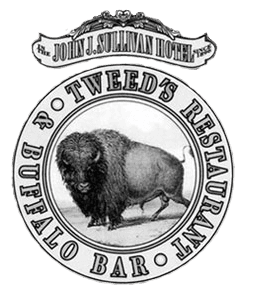Bison Meat Makes Inroads with American Gourmands
North Quarter Farm
In 1985, we purchased our first 2 bison - pregnant females from Custer State Park located in the Black Hills of South Dakota. A herd of 1,300 bison roams freely throughout this park; the herd is one of the largest publicly-owned herds in the world. Our foundation herd, the bulls, were purchased later on from a buffalo rancher and breeder, John Mulhern.
Since those initial purchases, our herd has grown through breeding and careful culling of animals for slaughter. Outside animals are not introduced into our herd. Today, North Quarter Farm boasts some 300-plus bison on 250 acres of farmland. The herd is grass fed in the warm months, with winter diets supplemented by local supplies of hay, potatoes, pumpkins, and brewery mash.
Bison or buffalo can weigh as much as 2000 pounds. Here at North Quarter Farm, the average weight of a female is about 1200 pounds, while a male is about 2200 pounds.

ABOUT BISON
Horns:
Both sexes have horns. The horns on bulls tend to go straight up, while those on the cows curve in.
Size:
Bulls are larger than cows. A bull can weigh a ton or more. A cow can weigh up to 1400 pounds. At birth calves weigh about 40 pounds .
Gestation:
Like humans, it takes about 9 months.
Age:
Buffalo can live much longer than domestic cattle that have a life expectancy of about 20 years. Cows [bison] can continue to calve right up into their forties.
Teeth:
If you could magically transfer one part of the buffalo into domestic cattle, you would probably pick teeth. The teeth of bison are incredibly sturdy. Unlike cattle that can loose teeth before the age of 10, bison hold on to their teeth a lot longer.
Stomachs:
Buffalo, like other ruminants, have 4 stomachs. After they eat something, it gets spit up again for re-chewing. When calves are first born, their first stomach folds into a tube allowing milk to be more quickly digested. Substances in the first stomach help with digestion of cellulose -- something humans cannot do.
Diseases:
Bison usually do not succumb to diseases like cattle, but they are not 100% immune. During the 1988 Yellowstone fires, bison became so stressed they developed pinkeye. Careful monitoring and periodic dosing for infectious bacterial agents such as Cryptococcosis keeps our herd healthy.
BISON HEART HEALTHY FACTS
Bison meat is inherently lean without sacrificing any of the flavor that is generally attributed to a high-fat content.
At our restaurant, we cook bison rare to medium-rare. By keeping the meat pink, our chefs make the most of the Bison’s wispy fat and in turn, preserve the meat’s robust flavor without any greasy aftermath.
Compare The Numbers
Total Fat per 100 grams of meat
Bison ………………………… 7.2 g
Chicken ……………………… 8.1 g
Beef 90% lean …………….. 10.0 g
Pork 84% lean ……………. 16.0 g
Cholesterol per 100 grams of meat
Bison ……………………….. 55.0 mg
Chicken ……………………. 86.0 mg
Beef 90% lean …………… 65.0 mg
Pork 84% lean ………….. 68.0 mg
Protein per 100 grams of meat
Bison ……………………… 20.23 g
Beef 90% lean ………….. 20.0 g
Pork 84% lean …………. 17.99 g
Chicken …………………… 17.44 g
